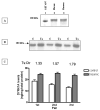Trisomy-driven overexpression of DYRK1A kinase in the brain of subjects with Down syndrome
- PMID: 17145134
- PMCID: PMC1890010
- DOI: 10.1016/j.neulet.2006.11.026
Trisomy-driven overexpression of DYRK1A kinase in the brain of subjects with Down syndrome
Abstract
Down syndrome (DS) is the most common genetic disorder associated with mental retardation (MR). It is believed that many of the phenotypic features of DS stem from enhanced expression of a set of genes located within the triplicated region on chromosome 21. Among those genes is DYRK1A encoding dual-specificity proline-directed serine/treonine kinase, which, as documented by animal studies, can potentially contribute to cognitive deficits in DS. Whether this contribution can be exerted through elevated levels of DYRK1A protein in the brain of DS subjects was the main goal of the present study. The levels of DYRK1A protein were measured by Western blotting in six brain structures that included cerebral and cerebellar cortices and white matter. The study involved large cohorts of DS subjects and age-matched controls representing infants and adults of different age, gender and ethnicity. Trisomic Ts65Dn mice, an animal model of DS, were also included in the study. Both in trisomic mice and in DS subjects, the brain levels of DYRK1A protein were increased approximately 1.5-fold, indicating that this protein is overexpressed in gene dosage-dependent manner. The exception was an infant group, in which there was no enhancement suggesting the existence of a developmentally regulated mechanism. We found DYRK1A to be present in every analyzed structure irrespective of age. This widespread occurrence and constitutive expression of DYRK1A in adult brain suggest an important, but diverse from developmental role played by this kinase in adult central nervous system. It also implies that overexpression of DYRK1A in DS may be potentially relevant to MR status of these individuals during their entire life span.
Figures



References
-
- Ahn K, Jeong H, Choi H, Ryoo S, Kim Y, Goo J, Choi S, Han J, Ha I, Song W. DYRK1A BAC transgenic mice show altered synaptic plasticity with learning and memory defects. Neurobiol Dis. 2006;22:463–472. - PubMed
-
- Altafaj X, Dierssen M, Baamonde C, Marti E, Visa J, Guimera J, Oset M, Gonzalez JR, Florez JR, Fillat C, Estivill X. Neurodevelopmental delay, motor abnormalities and cognitive deficits in transgenic mice overexpressing Dyrk1A (minibrain), a murine model of Down’s syndrome. Hum Mol Gene. 2001;10:1915–1923. - PubMed
-
- Becker LE, Armstrong DL, Chan F. Dendritic atrophy in children with Down’s syndrome. Ann Neurol. 1986;20:520–526. - PubMed
-
- Branchi I, Bichler Z, Minghetti L, Delabar JM, Malchiodi-Albedi F, Gonzales MC, Chettouh Z, Nicolini A, Chabert C, Smith DJ, Rubin EM, Migliore-Samour D, Alleva E. Transgenic mouse in vivo library of human Down syndrome critical region 1: Association between Dyrk1A overexpression, brain development abnormalities, and cell cycle protein alteration. J Neuropath Exp Neurol. 2004;63:429–440. - PubMed
-
- Chen-Hwang M-C, Chen H-R, Elzinga M, Hwang Y-W. Dynamin is a minibrain kinase/dual specificity Yak1-related kinase 1A substrate. J Biol Chem. 2002;277:7597–17604. - PubMed
Publication types
MeSH terms
Substances
Grants and funding
LinkOut - more resources
Full Text Sources
Other Literature Sources
Medical

